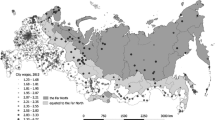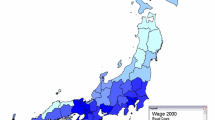Abstract
It is argued that the size of a region affects the spatial configuration of economic activities, known as the home market effect (HME). Concerning the definition of HME, it can be interpreted from different aspects, but most empirical studies testing HME focus mainly on investigating firm share and exports. This paper empirically investigates the HME in terms of wages in the case of China by using panel data for the period 1980–2012. We find that the wages in coastal regions are higher than those in the interior, due to the size differences between regions. Additionally, regional inequality in wages between the coastal and interior regions evolves in an inverted U-shaped curve during periods of regional integration. The evolution of the space-economy in China during the past three decades supports the inverted U-shaped pattern predicted by the theoretical models of spatial economics.


Similar content being viewed by others
Notes
The agricultural sector is assumed to exhibit a constant return to scale, perfect competition, homogeneity of goods, and zero transport costs.
It is noteworthy that, despite the close relationship between \(k_{i} (T)\) (firm share) and \(w_{i} (T)\) (wages) shown in (10), \(k_{i} (T)\) has a more complicated pattern when it is considered in multiregional situations. Zeng and Uchikawa (2014) investigate the relation between firm share and transport costs in a multiregional space and find that the \(k_{i}(T)\) presents a more complicated pattern response to T. This result implies that we have to be prudent when testing HME in multiple regions. It seems reasonable to choose to empirically investigate the U-shaped pattern in terms of wages rather than firm share.
The two main regions defined in this paper are the coastal ones and the interior ones. The coastal region consists of Liaoning, Beijing, Tianjin, Hebei, Shandong, Jiangsu, Shanghai, Zhejiang, Fujian, and Guangdong; the interior consists of the central provinces (Shanxi, Anhui, Jiangxi, Hunan, Henan, Hubei, Heilongjiang, Jilin) and those in the west (Gansu, Qinghai, Ningxia, Xinjiang, Inner Mongolia, Guangxi, Sichuan, Chongqing, Guizhou, Yunnan, and Shaanxi). We have excluded Xizang and Hainan from the western and coastal regions, respectively, due to lack of data.
References
Barrios S, Strobl E (2009) The dynamics of regional inequalities. Reg Sci Urban Econ 39:575–591
Behrens K, Roert-Nicoud F (2009) Krugman’s paper in regional science: the 100 dollar bill on the sidewalk is gone and the 2008 Nobel Prize well-deserved. Pap Reg Sci 88(2):467–490
Behrens K, Lamorgese AR, Ottaviano G, Tabuchi T (2009) Beyond the home market effect: market size and specialization in a multi-country world. J Int Econ 79:259–265
Combes P, Lafourcade M (2005) Transport costs: measures, determinants, and regional policy implications for France. J Econ Geogr 5:319–349
Davis DR (1998) The home market, trade, and industrial structure. Am Econ Rev 88:1264–1276
Davis DR, Weinstein DE (1999) Economic geography and regional production structure: an empirical investigation. Eur Econ Rev 43(2):379–407
Davis DR, Weinstein DE (2003) Market access, economic geography and comparative advantage: an empirical assessment. J Int Econ 59(1):1–23
Forslid R, Ottaviano G (2003) An analytically solvable core-periphery model. J Econ Geogr 3:229–240
Fujita M, Krugman P, Venables AJ (1999) The spatial economy: cities, regions and international trade. MIT Press, Cambridge
Fujita M, Hu DP (2001) Regional disparity in China 1985–1994: the effects of globalization and economic liberalization. Ann Reg Sci 35:3–37
Hanson G (2005) Market potential, increasing returns, and the geographic concentration. J Int Econ 67(1):1–24
Head K, Mayer T (2004) The empirics of agglomeration and trade. In: Henderson JV, Thisse J-F (eds) Handbook of regional and urban economics, vol 4. North Holland, Amsterdam
Head K, Mayer T (2006) Regional wages and employment responses to market potential in the EU. Reg Sci Urban Econ 36(5):573–594
Head K, Ries J (2001) Increasing returns versus national product differentiation as an explanation for the pattern of US–Canada trade. Am Econ Rev 91(4):858–876
Helpman E (1998) The size of regions. In: Pines D, Sadka E, Zilcha I (eds) Topics in public economics: theoretical and applied analysis. Cambridge University Press, Cambridge, pp 33–54
Helpman E, Krugman P (1985) Market structure and foreign trade: increasing returns, imperfect competition, and the international economy. MIT Press, Cambridge
Hering L, Poncet S (2010) Market access and individual wages: evidence from China. Rev Econ Stat 92(1):145–159
Krugman P (1980) Scale economies, product differentiation, and the pattern of trade. Am Econ Rev 70:950–959
Krugman P (1991) Increasing returns and economic geography. J Polit Econ 99:483–499
Krugman P (2011) The new economic geography, now middle-aged. Reg Stud 45:1–7
Ma AC (2006) Geographic location of foreign direct investment and wages inequality in China. World Econ 29(8):1031–1055
Martin P, Rogers CA (1995) Industrial location and public infrastructure. J Int Econ 39:335–351
Ottaviano GI, Tabuchi T, Thisse J-F (2002) Agglomeration and trade revisited. Int Econ Rev 43:409–436
Pflüger M (2004) A simple, analytically solvable, Chamberlinian agglomeration model. Reg Sci Urban Econ 34:565–573
Picard PM, Zeng D-Z (2005) Agricultural sector and industrial agglomeration. J Dev Econ 77:75–106
Picard PM, Zeng D-Z (2010) A harmonization of first and second natures. J Reg Sci 50(5):973–994
Pflüger M, Tabuchi T (2010) The size of regions with land use for production. Reg Sci Urban Econ 40(6):481–489
Puga D (1999) The rise and fall of regional inequalities. Eur Econ Rev 43:303–334
Redding SJ, Venables AJ (2004) Economic geography and international inequality. J Int Econ 62(1):53–82
Suedekum J (2006) Agglomeration and regional costs of living. J Reg Sci 46:529–534
Tabuchi T (1998) Agglomeration and dispersion: a synthesis of Alonso and Krugman. J Urban Econ 44:333–351
Tabuchi T, Thisse JF (2002) Taste heterogeneity, labor mobility and economic geography. J Dev Econ 69:155–177
Takahashi T, Takatsuka H, Zeng D-Z (2013) Spatial inequality, globalization, and footloose capital. Econ Theory 53:213–238
Takatsuka H, Zeng D-Z (2009) Dispersion forms: an interaction of market access, competition, and urban costs. J Reg Sci 49(1):177–204
Venables AJ (1996) Equilibrium locations of vertically linked industries. Int Econ Rev 37:951–958
Williamson J (1965) Regional inequality and the process of national development: a description of the patterns. Econ Dev Cult Change 13:3–84
Zeng D-Z (2006) Redispersion is different from dispersion: spatial economy of multiple industries. Ann Reg Sci 40(2):229–247
Zeng D-Z (2014) The role of country size in spatial economics: a survey of the home market effects. Proc Rijeka Fac Econ J Econ Bus 32(2):379–403
Zeng D-Z, Uchikawa T (2014) Ubiquitous inequality: the home market effect in a multicounty space. J Math Econ 50:225–233
Zheng X-P (2010) A cointegration analysis of dynamics externalities. Jpn World Econ 22:130–140
Acknowledgments
We particularly thank editor, two anonymous referees, Dao-Zhi Zeng, Shota Fujishima, Jacques-François Thisse, Hajime Takatsuka and Xiwei Zhu for providing exceptionally detailed and helpful comments and suggestions to improve this paper. Thanks also extend to the scholars for their highly valuable comments on the presentation of this paper in the 4th and the 5th Asia Seminars in Regional Science at Seoul National University and Harbin Institute of Technology. Financial supports from National Natural Science Foundation of China (No.71503161) and the Jiangsu General Project Fund of Philosophy and Social Sciences (No. 2015SJD348) are gratefully acknowledged.
Author information
Authors and Affiliations
Corresponding author
Rights and permissions
About this article
Cite this article
Wang, J., Xu, J. Home market effect, spatial wages disparity: an empirical reinvestigation of China. Ann Reg Sci 55, 313–333 (2015). https://doi.org/10.1007/s00168-015-0700-2
Received:
Accepted:
Published:
Issue Date:
DOI: https://doi.org/10.1007/s00168-015-0700-2




